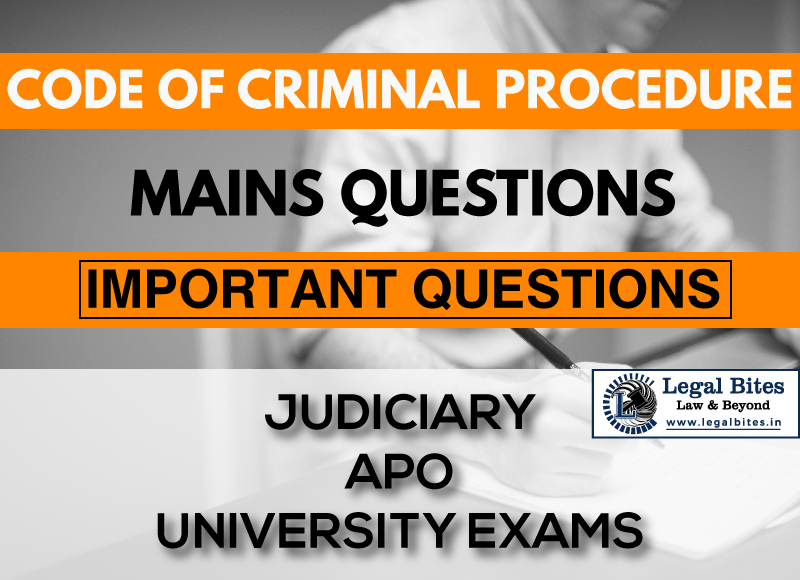Guidelines And Procedure For Grant Of Bail Under Cr.P.C
Guidelines And Procedure For Grant Of Bail Under Cr.P.C | Overview Introduction What is Bail? Pre-requisites to Grant of Bail Guidelines and Procedure for Mandatory Bail Guidelines and Procedure for Discretionary Bail References Introduction The article discusses the Guidelines And Procedure For Grant Of Bail Under The Code Of Criminal Procedure. Article 21 of the Indian Constitution prohibits… Read More »
;
Guidelines And Procedure For Grant Of Bail Under Cr.P.C | Overview Introduction What is Bail? Pre-requisites to Grant of Bail Guidelines and Procedure for Mandatory Bail Guidelines and Procedure for Discretionary Bail References Introduction The article discusses the Guidelines And Procedure For Grant Of Bail Under The Code Of Criminal Procedure. Article 21 of the Indian Constitution prohibits the deprivation of personal liberty of a person by any act of the State or its...
Guidelines And Procedure For Grant Of Bail Under Cr.P.C | Overview
- Introduction
- What is Bail?
- Pre-requisites to Grant of Bail
- Guidelines and Procedure for Mandatory Bail
- Guidelines and Procedure for Discretionary Bail
- References
Introduction
The article discusses the Guidelines And Procedure For Grant Of Bail Under The Code Of Criminal Procedure. Article 21 of the Indian Constitution prohibits the deprivation of personal liberty of a person by any act of the State or its instrumentalities. Bail is one such measure to ensure that no one is unnecessarily detained and deprived of their personal liberty.
The Criminal Procedure Code, 1973 provides for the guidelines and procedure that a trial court should consider during the grant of bail. Grant of bail, in any case, depends upon the nature of the offence accused of. If the offence is bailable under Schedule I of the Code, bail is a legal right and guidelines and procedure for grant of bail is not rigid whereas if the offence is non-bailable, several determinants need to be conformed to.
What is Bail?
Bail is often confused as a process of release of an accused while the trial is pending. However, when a person is enlarged on bail, it is simply said ‘he is released or enlarged on bail’. Bail is not the process of release but the amount of money paid by an accused to the judicial authority for the grant of bail. The court is also empowered to order the accused to execute a bond with or without sureties besides the bail amount for his release.
Bond is a personal declaration by the accused person that he will attend the trial or inquiry whenever he is required and will not be absent from such proceedings. If the accused does not attend the proceeding even after the bond and bail, he may be arrested and his future applications for bail may be rejected.
Pre-requisites to Grant of Bail
First of all, it has to be noted that bail is of two kinds, Mandatory Bail and Discretionary Bail. Section 436 of Cr.P.C deals with the guidelines and procedure for grant of mandatory bail while Section 437 provides for the grant of discretionary bail. These provisions deal specifically with the powers of the Courts of Judicial Magistrates to grant bail and do not apply to Sessions Court and High Court. Section 439 empowers the Court of Session and High Court to grant bail in certain circumstances.
The Hon’ble Supreme Court in the case of State of Maharashtra v. Sitaram Popat Vital observed certain factors that the courts should consider while deciding whether bail should be granted or not.
“Firstly, the nature of accusation and the severity of punishment in case of conviction and the nature of supporting evidence, secondly, reasonable apprehension of tampering of the witness or apprehension of threat to the complainant, thirdly, prima facie satisfaction of the Court in support of the charge” [1].
Guidelines and Procedure for Mandatory Bail
The Code states that “when a person is arrested by a police officer without a warrant for the commission of an offence which is bailable in nature under the Cr.P.C, the accused has a right to be released if he is willing to furnish the amount of bail. This right to be released on bail can be exercised either when the person is under police custody or when he is brought before the Magistrate for remand”[2]. The essential guidelines for grant of bail under Section 436 can be enumerated as follows:
- The offence accused of must be shown as bailable under Schedule I to the Cr.P.C.
- If the offence is not one punishable under the Indian Penal Code, 1860, it must be made bailable by the statute that creates the offence. If the statute is silent on the nature of the offence, the seriousness of the offence is taken into consideration. If the offence is punishable with an incarceration period of fewer than three years, it is considered to be less heinous and hence, bailable.
- The accused must be arrested without a warrant and he must be under the custody of the police to allow the Magistrate to grant bail.
- The accused must be ready and willing to furnish the amount of bail as decided by the concerned Magistrate.
If the Magistrate is of the opinion that the above guidelines have been followed and the accused is entitled to be released and he is willing to furnish the bail amount, the Magistrate shall follow the procedure described in Section 436 (1) and (2) to grant bail.
- The Magistrate shall release the person as soon as he pays the bail amount.
- The Magistrate may impose any condition to such bail which the accused, while he is released on bail, must fulfil. For instance, the most common condition is to prove his presence to the nearest police station from the place of his residence every week during the period of release.
- If the Magistrate believes that the offence committed is petty in nature and/or the accused is not likely to abscond from justice, he may discharge the accused on executing a bond for his presence during the trial with or without sureties instead of a bail amount.
- The Magistrate can also impose conditions when the person is released on bond in lieu of bail.
- Further, if the accused fails to comply with conditions of bail or bond and does not appear before the court on the given time and place, the court may refuse to release him on bail in any subsequent applications.
Guidelines and Procedure for Discretionary Bail
According to Section 437, if a person is arrested without a warrant for the commission of an offence which is non-bailable in nature, the grant of bail is completely at the discretion of the trial court, i.e. the court of Judicial Magistrate. The section provides certain guidelines to be followed while granting bail in a non-bailable offence.
- The offence accused of must be shown as non-bailable under Schedule I to the Cr.P.C.
- If the offence is not one punishable under the Indian Penal Code, 1860, it must be made non-bailable by the statute that creates the offence. If the statute is silent on the nature of the offence, the seriousness of the offence is taken into consideration. If the offence is punishable with an incarceration period of three years or more, it is considered to be a grave offence and hence, non-bailable.
- The accused must be arrested without a warrant and he must be under the custody of the police to allow the Magistrate to grant bail.
- The accused must be ready and willing to furnish the amount of bail as decided by the concerned Magistrate.
- The court must not have the option to trust that the person accused of an offence is guilty of an offence punished with capital punishment or life incarceration.
- The offence must not be a cognizable offence or there must not be the trace of any recidivism specifically of an offence punishable with the incarceration of seven years or more including the death penalty.
- The accused person should not have prior convictions amounting to more than one and such convictions must not include a heinous offence.
As it is crystal clear from the above list that bail in case of the non-bailable offence goes through a rigid process and the courts must conform to all the guidelines stated above before deciding on the question of bail. After the court is satisfied that the above guidelines have been followed, the following procedure needs to be adhered to when finally bail is granted.
- The judicial authority may enlarge the accused on bail if the above guidelines are conformed to and the accused person is ready and can afford to pay the bail amount.
- It may allow a person referred in clause (v), (vi) and (vii) of the above guidelines to be discharged in special circumstance is the person is a minor below sixteen years of age or is irresolute.
- The court may also release any person referred above if the court believes that there is any special reason for doing so which must be stated in writing.
- The court should not refuse the bail to any person on the ground that his attendance is required for identification by the victim or the witnesses. The accused can be brought for identification while he is on bail at the requisite place whenever required.
- If the court has reason to believe that though sufficient grounds exist to indicate the guilt of the accused, further inquiry and investigation is still required to prove his guilt, the court may release the accused on bail.
- Further, if the accused is not likely to abscond from justice, the Magistrate may discharge the accused on executing a bond for his presence during the trial with or without sureties instead of a bail amount.
- The Magistrate can also impose conditions when the person is released on bond in lieu of bail.
- Further, if the accused does not adhere to the prerequisites of bail or personal bond and does not appear before the court on the given time and place, the court may refuse to release him on bail in any subsequent applications.
Besides the above procedure, the courts have also laid down additional procedures while in their efforts of interpreting these provisions. The Hon’ble Supreme Court in the matter of Ram Govind Upadhyay v. Sudarshan Singh and Ors. “while considering various factors for grant of bail has analyzed the scenario where the applicant has already been in custody and the trial is not likely to conclude for some time, which can be characterized as unreasonable” [3], bail could be granted in such circumstances.
With respect to imposition of condition on grant of bail or execution of bond, the Supreme Court in Sumit Mehta v. State of NCT of Delhi observed that the expression ‘any condition’ mentioned in Section 437 (3) “should not be regarded as conferring carte blanche on a Court of law to impose any condition that it chooses to impose” [4]. The court held that “any condition has to be interpreted as a reasonable condition acceptable in the facts permissible in the circumstance and effective in the pragmatic sense and should not defeat the order of grant of bail”[5].
References
- N. Chandrashekaran Pillai, R.V. Kelkar’s Criminal Procedure (6th ed. 2018).
- Ratanlal & Dhirajlal, Commentary on the Code of Criminal Procedure (18th 2006).
- D. Gaur, Textbook on the Code of Criminal Procedure (1st ed. 2016).
[1] State of Maharashtra v. Sitaram Popat Vital, AIR 2004 SC 4258.
[2] §436, Cr.P.C, 1973.
[3] Ram Govind Upadhyay v. Sudarshan Singh and Ors., AIR 2002 SC 1475.
[4] Sumit Mehta v. State of NCT of Delhi,
[5] Ibid.
- Examination of Accused as a Defense Witness: Purpose and Procedure(Opens in a new browser tab)
- Plea of Guilt and Plea Bargaining Under the Cr.P.C, 1973(Opens in a new browser tab)



